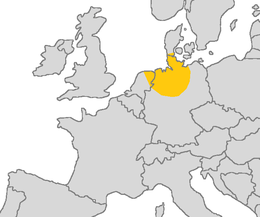lingvo.wikisort.org - Lingua
Il sassone antico, anche basso tedesco antico, è una lingua germanica. È la più antica forma linguistica registrata appartenente al ceppo delle lingue germaniche continentali, sviluppatasi tra il nono e il Dodicesimo secolo, oltre il quale si è evoluta nel basso tedesco medio. Era parlata sulle coste nord-ovest della Germania e in Danimarca dove abitavano i popoli sassoni. La lingua è particolarmente vicina ai dialetti anglo-frisoni come frisone antico e antico inglese.
|
Questa voce o sezione sull'argomento lingue non cita le fonti necessarie o quelle presenti sono insufficienti.
|
| Sassone antico Sahsisk | |
|---|---|
| Locutori | |
| Totale | estinta |
| Tassonomia | |
| Filogenesi | Lingue indoeuropee Lingue germaniche Lingue germaniche occidentali |
| Codici di classificazione | |
| ISO 639-3 | osx (EN)
|
| Glottolog | olds1250 (EN)
|
 | |
Sono sopravvissuti pochi testi scritti della lingua, in gran parte voti battesimali a cui i Sassoni dovevano sottoporsi successivamente alla conquista dei loro territori da parte di Carlo Magno. L'unico testo letterario di una certa entità giunto fino ai giorni nostri è Heliand, "il Salvatore".
Alcune parole in sassone antico dal dizionario glosbe
- "Pericolo" in sassone antico: gifār, fāra, fār.
- "Popolo" in sassone antico: folk.
- "Pesce" in sassone antico: fisk.
- "Portare" in sassone antico: beran, bringan.
- "Realizzare" in sassone antico: fremmian, frummian, gifrummian.
Caratteristiche fonologiche
L'antico sassone, insieme ad altri dialetti dei dintorni, forma un gruppo separato di lingue germaniche, il gruppo del Mare del Nord. La lingua non partecipa alla mutazione consonantica dell'alto tedesco, quindi conserva le consonanti sorde p, t, k che sono diventate in alto tedesco varie affricate e fricative. I dittonghi germanici ai, au si sviluppano consistentemente nelle vocali lunghe ē, ō, mentre invece in alto tedesco essi appaiono come ei, eu o ē, ō, dipende dalla consonante seguente. L'antico sassone, unico caso nelle lingue germaniche occidentali, preserva consistentemente la -j- del germanico dopo una consonante, hēliand ‘salvatore’ (cfr. antico alto tedesco heilant, antico inglese hǣlend, gotico háiljands). La metafonia germanica, quando si manifesta su a, è inconsistente, ad es. hebbean, habbian ‘avere’ (cfr. inglese antico hebban). Questa caratteristica fu riportata all'interno della lingua discendente dell'antico sassone, il basso tedesco medio, dove p.e. l'aggettivo krank ‘malato’ ha le forme comparative krenker e kranker.
Opere in sassone antico
- Heliand
- Omelia di Beda (Homilie Bedas)
- Frammenti della Genesi[1]
- Trierer Blutsegen
- Wurmsegen
- Spurihalz
- Voto battesimale
- Commenti ai Salmi (Gernroder Psalmenkommentars)
- Penitenziario (Westfälische Beichte)
- Credo
- Essener Heberegister
Note
- Frammenti della Genesi, su titus.uni-frankfurt.de.
Altri progetti
 Wikimedia Commons contiene immagini o altri file su antico sassone
Wikimedia Commons contiene immagini o altri file su antico sassone
Collegamenti esterni
- Parole rintracciabili sul dizionario online Glosbe
- (EN) Lingua sassone antica, su Enciclopedia Britannica, Encyclopædia Britannica, Inc.
- Vocabolario di antico sassone scaricabile in formato PDF
- Grammatica scaricabile
| Controllo di autorità | Thesaurus BNCF 19113 · LCCN (EN) sh85094563 · BNF (FR) cb11945980v (data) |
|---|
На других языках
[de] Altsächsische Sprache
Die altsächsische Sprache (abgekürzt As.) oder die altniederdeutsche Sprache (abgekürzt And.) ist die älteste Sprachstufe des Niederdeutschen („Plattdeutschen“). Sie wurde zwischen dem 9. und 12. Jahrhundert im Siedlungsgebiet der Sachsen und der Angeln gesprochen, bildet die Vorläuferin des Mittelniederdeutschen und gehört zur Gruppe der westgermanischen Sprachen bzw. innerhalb dieser zur Gruppe der nordseegermanischen Sprachen.[1][2][en] Old Saxon
Old Saxon, also known as Old Low German, was a Germanic language and the earliest recorded form of Low German (spoken nowadays in Northern Germany, the northeastern Netherlands, southern Denmark, the Americas and parts of Eastern Europe). It is a West Germanic language, closely related to the Anglo-Frisian languages.[1] It is documented from the 8th century until the 12th century, when it gradually evolved into Middle Low German. It was spoken throughout modern northwestern Germany, primarily in the coastal regions and in the eastern Netherlands by Saxons, a Germanic tribe that inhabited the region of Saxony. It partially shares Anglo-Frisian's (Old Frisian, Old English) Ingvaeonic nasal spirant law which sets it apart from Low Franconian and Irminonic languages, such as Dutch, Luxembourgish and German.[es] Sajón antiguo
Sajón antiguo, también conocido como bajo alemán antiguo, es una lengua germánica. Es la forma registrada más temprana del bajo alemán, y está documento entre el siglo VIII y el siglo XII, fecha a partir de la cual se inicia el bajo alemán medio. Se hablaba en las costas noroccidentales de Alemania y Dinamarca habitadas por el pueblo sajón. Está relacionado con el anglofrisio antiguo (frisio antiguo, inglés antiguo), participando parcialmente de la ley de aspiración nasal ingvaeónica. Muy probablemente era inteligible con el antiguo anglosajón. También está relacionado con el antiguo bajo franconio ("antiguo holandés").[1][fr] Vieux saxon
Le vieux saxon est daté du Ve siècle jusqu'au XIe siècle. C'est une langue multi-dialectale attestée, non pas une proto-langue (c'est-à-dire une langue reconstituée).- [it] Lingua sassone antica
[ru] Древнесаксонский язык
Древнесаксо́нский язык, также известен как древненижнегерма́нский язык — самая ранняя форма нижненемецкого языка[1], подтверждённая документами VIII—XII веков. Из него развился средненижненемецкий язык. На нём говорили саксы на северо-западном побережье Германии и в Нидерландах. Древнесаксонский достаточно близок древним англо-фризским языкам (древнефризский язык, древнеанглийский язык); он также близок древненижнефранкскому языку («древнеголландский язык»). Этот язык отличается от древневерхненемецкого языка отсутствием следов второго передвижения согласных. Был взаимопонятен с древнеанглийским языком[2].Другой контент может иметь иную лицензию. Перед использованием материалов сайта WikiSort.org внимательно изучите правила лицензирования конкретных элементов наполнения сайта.
WikiSort.org - проект по пересортировке и дополнению контента Википедии